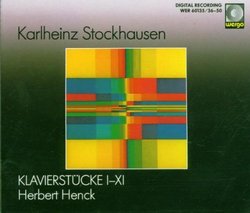| All Artists: Stockhausen, Henck Title: Klavierstucke 1-11 Members Wishing: 2 Total Copies: 0 Label: Wergo Germany Release Date: 12/8/1993 Album Type: Import Genre: Classical Styles: Instruments, Keyboard Number of Discs: 2 SwapaCD Credits: 2 UPCs: 4010228613520, 093046260125 |
Search - Stockhausen, Henck :: Klavierstucke 1-11
 | Stockhausen, Henck Klavierstucke 1-11 Genre: Classical
|
Larger Image |
CD Details |
CD ReviewsPiano gems,edifices,fragments that never made mainstream Rachel Abbinanti (tusai1@aol.com) | Chicago | 05/25/1999 (5 out of 5 stars) "Stockhausen's various "klavierstuck" have entered piano repertoire not physically but from a distance Since Stockhausen thinks he communes with extraterrestrial spirits this is a complement. It seems every great pianist from Rubenstein to Argerich to Pollini to Van Cliburn Finalists all know these piano pieces but never play them. Stockhausen wrote these pieces throughout the Fifties a time of the soaringly high avant-garde and envisioned them as extensions and sketch-ideas for his larger works.The first four are collected under one-leaf and exhibit miniature structures,pointillistic,searing contrasts of dynamics and tones magnetized and collected into regions or fields. These first four are still my favorites as if a good idea has not gone bad yet. With #5 and especially #6 we have a breakthrough of concept with new graphic notation to extend the compositional idea of gradations of tempi slowly accelerating. A graph above the music helps the performer to track these tempi microscopic changes and Stockhausen here ups the length.#7 is evocative with the first extended use of pure piano harmonics,that's where you silently depress a key and play another that rings tones in fundamental overtone congruence. Henck throughout this piano encyclopedia brings a gentleness to what is primarily coldly conceive music. #9 is the one most play and utilizes incessant repetitive tones in strident atonal intervals. Today all this sounds quite tame despite the fact that this music literally scared to death the likes of Philip Glass, these pieces have lost their ability to shock, well that's what postmodernity has done, and is why we like more tunefull,goal-directed music these days. A tour de force is still #10, a Listzian extravaganza with silences(not Cage) utilized as afterthoughts to mirror the piano's reverberations with as-fast-as-possible filigree lines and armfulls of clusters. And #11 is the indeterminate labyrinth, where the pianist is confronted with a map-like page, three-feet by three- feet, and the performer slowly works their way through the fragments. Henck is a devoted interpreter of all this, and worked directly with Stockhausen as well as concertizing throughout Europe with these pieces. A great collection and unless you have David Tudor or Aloys Kontarsky you won't find these recorded at least not on this planet." Great piano playing but not the best recording technique 12/28/2002 (4 out of 5 stars) "Herbert Henck worked with the Stockhausen Ensemble in the early 1970's, and he is a great pianist, really one of the best in the avantgarde repertoire. His interpretations of Pierre Boulez's piano sonatas (Wergo), John Cage's Music of Changes (Wergo), and Jean Barraque's sonata (ECM), just to mention a few examples, are probably the best you can find. Henck has written an academic essay on Stockhausen's Piano Piece X (by the way, my favorite in this series), and he provided a remarkable interpretation of this relatively long piece. However, I gave "4 stars" to this album, and the reason is the recording technique. I have the impression that the recording engineer placed the listener distant from the instrument as in a large concert room. From Stockhausen's writtings it is evident the he considered the ideal situation if the listener could have his/her ears as near as possible the piano strings. In recent performances of the Piano Pieces under supervision of the Composer the solution has been to reinforce the piano sound in a proper way with loudspearkers controlled by a sound projectionist. I think that the golden standard for Stockhausen's Piano Pieces I-XI is surely the recording with Alois Kontarsky (recorded in 1965 under supervision of the Composer, currently available in a double-CD box including Microphonie I & II, Sony Music, and erroneously classified in this site under "popular music"! - so search under "popular music" and you will find it). The recent recording with Ellen Corver (Stockhausen-Verlag) is also superb, and the more recent Piano Pieces XII-XIV were also included."
|

 Track Listings (8) - Disc #1
Track Listings (8) - Disc #1